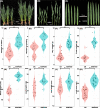Silica nanoparticles promote wheat growth by mediating hormones and sugar metabolism
- PMID: 36593514
- PMCID: PMC9808955
- DOI: 10.1186/s12951-022-01753-7
Silica nanoparticles promote wheat growth by mediating hormones and sugar metabolism
Abstract
Background: Silica nanoparticles (SiNPs) have been demonstrated to have beneficial effects on plant growth and development, especially under biotic and abiotic stresses. However, the mechanisms of SiNPs-mediated plant growth strengthening are still unclear, especially under field condition. In this study, we evaluated the effect of SiNPs on the growth and sugar and hormone metabolisms of wheat in the field.
Results: SiNPs increased tillers and elongated internodes by 66.7% and 27.4%, respectively, resulting in a larger biomass. SiNPs can increase the net photosynthetic rate by increasing total chlorophyll contents. We speculated that SiNPs can regulate the growth of leaves and stems, partly by regulating the metabolisms of plant hormones and soluble sugar. Specifically, SiNPs can increase auxin (IAA) and fructose contents, which can promote wheat growth directly or indirectly. Furthermore, SiNPs increased the expression levels of key pathway genes related to soluble sugars (SPS, SUS, and α-glucosidase), chlorophyll (CHLH, CAO, and POR), IAA (TIR1), and abscisic acid (ABA) (PYR/PYL, PP2C, SnRK2, and ABF), whereas the expression levels of genes related to CTKs (IPT) was decreased after SiNPs treatment.
Conclusions: This study shows that SiNPs can promote wheat growth and provides a theoretical foundation for the application of SiNPs in field conditions.
Keywords: Chlorophyll; Growth; Photosynthesis; Plant hormone; Soluble sugar; Wheat.
© 2023. The Author(s).
Conflict of interest statement
The authors declare that they have no competing interests.
Figures








References
-
- Giraldo P, Benavente E, Manzano-Agugliaro F, Gimenez E. Worldwide research trends on wheat and barley: a bibliometric comparative analysis. Agronomy. 2019;9:352. doi: 10.3390/agronomy9070352. - DOI
-
- Clarke FR, Clarke JM, DePauw RM, Fernandez MR, Fox S, Gilbert J, Humphreys G, Knox RE, McCaig TN, Procunier D. Strategic approach to mitigating weather induced defects of wheat quality. Euphytica. 2005;143:285–290. doi: 10.1007/s10681-005-7883-z. - DOI
-
- Gou TY, Chen XH, Han R, Liu JQ, Zhu YX, Gong HJ. Silicon can improve seed germination and ameliorate oxidative damage of bud seedlings in cucumber under salt stress. Acta Physiologiae Plantarum. 2020;42:1. doi: 10.1007/s11738-019-3007-6. - DOI
MeSH terms
Substances
Grants and funding
LinkOut - more resources
Full Text Sources

